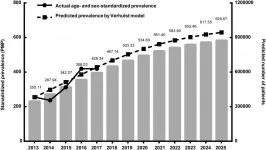(Press-News.org) Traditional gendered patterns of child care persisted during the COVID-19 shutdown, with more than a third of couples relying on women to provide most or all of it, according to a study from University of Georgia researcher Kristen Shockley.
Some previous research has found that typical familial patterns may get upended during crises, but that's not what Shockley and her colleagues found in the early months of the COVID-19 shutdown.
"Most people have never undergone anything like this before, where all of a sudden they can't rely on their normal child care, and most people's work situation has changed too," said Shockley, associate professor of psychology in the Franklin College of Arts and Sciences. "We thought this would be a chance for men to step in and partake equally in child care, but for many couples we didn't see that happen."
In mid-March, as schools and day cares closed and many shifted to remote work, Shockley and her colleagues quickly created a survey targeting dual-earner couples with at least one child under age 6.
"My son was 15 months old when this all started, and I know firsthand that you can't just plop younger kids in front of a TV or expect them to do their schoolwork," she said. "We were particularly interested in people who really had to provide active child care."
The team initially surveyed 274 couples, conducting a follow-up survey with 133 of the same couples in May. The study, which will appear Journal of Applied Psychology, assessed marital tension, health and job performance in addition to child care strategies.
"When the wife does it all, not surprisingly, the outcomes are bad for the couple," Shockley said. "It's not just bad for the wife, it's also bad for the husband, including in terms of job performance although his work role presumably hasn't changed. When one person's doing it all, there's a lot of tension in the relationship, and it's probably spilling over into the husband's ability to focus at work."
Though 36.6% of couples relied on the wife to provide most or all child care, 44.5% used more egalitarian strategies, and 18.9% used strategies that were not clearly gendered or egalitarian.
Egalitarian strategies included alternating work days, planning daily mini shifts that included both work and child care for husband and wife, and alternating shifts that changed day to day based on the couple's work needs.
"When you look at the more egalitarian strategies, we found the best outcomes for people who were able to alternate working days," Shockley said. "The boundaries are clear. When you're working, you can really focus on work, and when you're taking care of the kids, you can really focus on the kids. But not everybody has jobs amenable to that."
When both people were working at home, planned mini shifts and needs-based alternation had similar well-being outcomes for the couple, but job performance was higher for couples who used needs-based alternation, according to Shockley.
"I think that's due to the communication that comes with it, and the flexibility within your dyad at home," she said. "For couples who are continuing to work remotely, I would say needs-based alternation with night-before communication about work needs is probably better than having fixed shifts."
Although the paper doesn't include qualitative quotes, Shockley remembers the participants' comments quite clearly.
"People were saying, 'I'm at my breaking point,' and this was just two weeks in. A lot of people said, 'I'm just not sleeping.' You could feel people's struggle, and there was a lot of resentment, particularly when the wife was doing it all," she said.
"This really highlights some infrastructure issues we have with the way we think about child care in this country. The default becomes, 'Oh well, the wife is going to pick up the slack.' It's not a long-term solution."
Shockley also noted that the couples surveyed have relatively high incomes.
"Compared to the country, the household income of our study is pretty high," she said. "This might look different in lower-income samples. We might see totally different strategies emerging, particularly if there's less possibility for remote work."
INFORMATION:
Co-authors include Malissa A. Clark and Hope Dodd at UGA and Eden B. King at Rice University.
North Carolina did not expand Medicaid eligibility under the Affordable Care Act, which continued to put many low-income women at risk for losing health care coverage post partum. The state did comply with ACA standards for simplifying Medicaid enrollment, automating the process and removing a stringent and often cumbersome financial assessment process. Analysis from researchers at Duke University found that these reforms enabled more low-income women to qualify for full Medicaid and reduced the number of women who instead qualified for more limited benefits under the state's ...
A rapid, evidence-based review summarizes the effectiveness of cloth masks in protecting health care clinicians from respiratory viral infections, such as COVID-19. Nine studies were included in the review, and all but one were conducted prior to the COVID-19 pandemic. The only randomized trial of cloth face masks published at the time of this review compared the infection rates of influenza-like illness among groups of health care professionals who wore cloth masks, medical masks, or inconsistent mask use in the hospital setting. That study reported wide-ranging confidence intervals ...
Despite having some of the densest living spaces and the highest number of international visitors, Hong Kong, Singapore, and Beijing have utilized their respective primary health care systems to keep their COVID-19 cases and deaths relatively low. Researchers studied the primary health care systems in the three cities to identify features of each system that other cities can use as examples to prepare for and prevent deaths in future health crises. Wong et al write that all three cities have made use of primary care in performing public health surveillance and ...
Physical pain and social pain may be more closely related than previously thought. Social pain, which typically results from interpersonal rejection or abuse, has been viewed as a non-medical response to external factors. However, recent research suggests that some physical and social stress responses may arise because of shared processing in the brain. Long-term usage of opioid medications could perpetuate a cycle of experiencing both physical and social pain and may increase risk of addiction. The authors, both of whom prescribe opioid medications, caution, "We must recognize ...
Despite seeing gains in insurance coverage for preventive health services under the Affordable Care Act, the US has seen a declining rate of primary care visits over the past fifteen years. Are fewer individuals seeing primary care physicians? The authors of this study compared two factors that contribute to that decline to determine whether it was the number of primary care patients or the frequency of their clinical visits that contributed most to the overall decline. Over a fifteen year period from 2002 to 2017, both the number of unique patients seeing PCPs and the number of visits per patient declined. At the start of their analysis in 2002, most Americans saw a primary care physician about 4.3 times in a two-year span. By the end of the study in 2016, frequency ...
Patients are sometimes asked to share their personal health information for research purposes. Informed consent and trust are critical components in a patient's decision to participate in research. Researchers at the University of Florida conducted a three-arm randomized controlled trial to compare the effects on patient experiences of three electronic consent (e-consent) designs that asked them to share PHI for research purposes. Participants were randomized to a standard e-consent form (standard); an e-consent that contained standard information plus hyperlinks to additional interactive details (interactive); or an e-consent that contained standard information, interactive hyperlinks, and factual ...
URBANA, Ill. - Soil erosion is a major challenge in agricultural production. It affects soil quality and carries nutrient sediments that pollute waterways. While soil erosion is a naturally occurring process, agricultural activities such as conventional tilling exacerbate it. Farmers implementing no-till practices can significantly reduce soil erosion rates, a new University of Illinois study shows.
Completely shifting to no-till would reduce soil loss and sediment yield by more than 70%, says Sanghyun Lee, doctoral student in the Department of Agricultural and Biological Engineering at U of I and lead author on the study, published in Journal of Environmental Management.
But even a partial change in tilling practices could have significant results, he adds.
"If we ...
Harmful medical practices, like inappropriate prescribing of opioids and racial and income-based discrimination in clinical settings, can vary across medical practices and individuals. Patients may find that even common primary care health services, like getting a chest x-rays or a referral to a heart or lung specialist, can differ widely depending on your doctor or clinic location. These variations in medical practice can have serious consequences for the quality, equity and cost of one's health care; however, it's unclear whether these disparities can be attributed to individual differences, from one ...
Researchers at the University of Maryland, Baltimore County (UMBC) have developed a technique to more quickly analyze extensive data from Arctic ice sheets in order to gain insight and useful knowledge on patterns and trends. Over the years, vast amounts of data have been collected about the Arctic and Antarctic ice. These data are essential for scientists and policymakers seeking to understand climate change and the current trend of melting. Masoud Yari, research assistant professor, and Maryam Rahnemoonfar, associate professor of information systems, have utilized new AI technology to develop a fully automatic technique to analyze ice data, published in the Journal ...
Study published in the American Journal of Kidney Diseases (AJKD) projects that prevalence of patients receiving dialysis in China will increase from 384.4 patients per million (PPM) in 2017 to 629.7 PMP in 2025 with a predicted 874,373 patients receiving dialysis in 2025.
The national prevalence of dialysis in China has not been well studied due to its large population and limited resources. Insurance claims data provide a unique opportunity to understand the burden of kidney failure and have been used to characterize dialysis patients in the ...

